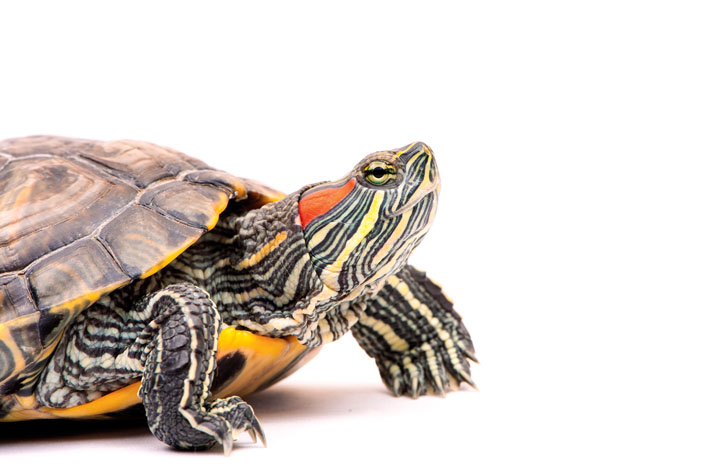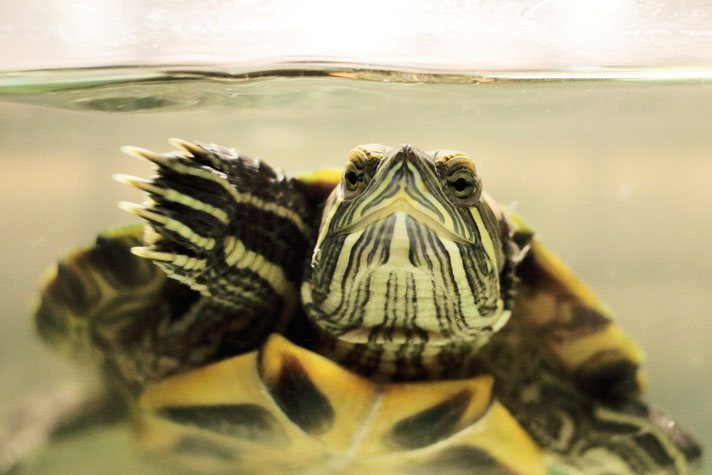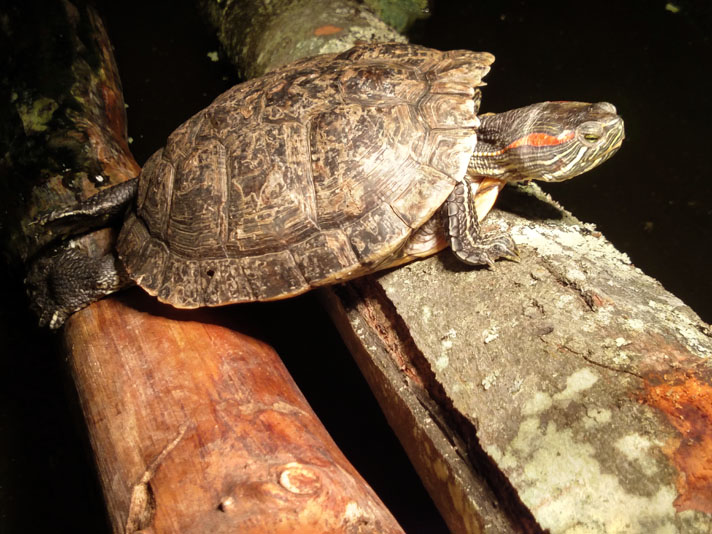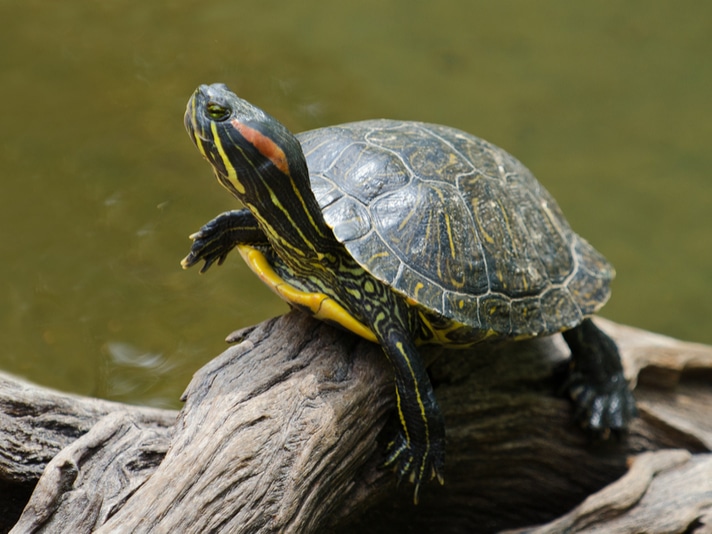Due to demanding long-term needs, keeping this beautiful turtle can be a double-edged sword.
There’s something to be said about having a companion animal or pet, if you will. Some people prefer dogs, some prefer cats and still others prefer birds. There is, however, an entirely different culture of those who prefer to keep the more unusual companion animal, and their numbers are growing. They are the turtle keepers, and the red-eared slider is the epicenter of turtle keeping!

baishev/shutterstock
Red-eared sliders are hardy pets, and given the proper care they can live for 30 years or longer in captivity.
I remember visiting a pet store as a young boy with my family in the early 70s when my brother picked out a few baby turtles for his birthday. I was amazed by the multitude of tiny, shelled treasures I saw crammed into numerous glass aquariums with barely enough space to move about. I later spent a great deal of time sitting quietly, watching my older brother’s small, lime-green turtles walking around aimlessly in their shallow plastic tub of water while I wondered how this all came about.
Little did I realize, at the time, that my early experiences with my older brother’s baby red-eared sliders would be a major stone in the path that would lead to my career in herpetology.
The Red-Eared Slider
Originally described in 1839 by German naturalist Alexander Philipp Maximilian, the red-eared slider received its taxonomy position as Emys elegans. Because of this turtle’s widespread familiarity and interest both in the scientific community and the private sector, the red-eared slider went through numerous nomenclatural changes by many well-known scholars in the field of herpetology throughout the years. Currently, the red-eared slider is known as Trachemys scripta elegans and shares sub-specific status with the Cumberland terrapin (T. s. troostii) and the yellow-bellied slider (T. s. scripta).
Originating naturally from areas surrounding the Mississippi River, the red-eared slider is a widespread species that inhabits an area that encompasses most of the central United States as far north and west as Illinois and eastern New Mexico, south to Texas, east through Georgia and likely coastal areas as far north as Virginia along the eastern seaboard. This turtle acclimates very easily outside of its natural range, making it difficult to specify its actual range.
Big, Beautiful, Busy
A rather large turtle when full-grown, the female red-eared slider has been known to reach a carapace length of 12 to 15 inches while the smaller male averages an adult size of about 8 to 10 inches in carapace length.
Attractive in appearance, red-eared sliders come in a multitude of colors including red, yellow, green, light blue, brown and black, with various shades and combinations of each often being present. In most cases, the bright colors and patterns become obscured when the turtle’s shell takes on its typical darker brown, black or olive green color with only hints of the pre-existing color and pattern scheme. Because it is a species with a wide variety of colors and patterns, some dedicated herpetoculturists have produced, through selective breeding, beautiful specimens of albino, pastel- and lime-colored red-eared sliders.
Want To Learn More?
A History Of The Pet Hatchling Aquatic Turtle Trade In The United States
Intricate patterning and a brilliant red stripe along each side of the turtle’s head make the red-eared slider stand out among other aquatic turtles, defining its identification immediately. Although both male and female red-eared sliders do possess the red-colored head striping, this is not a characteristic shared only by this species. The Cumberland terrapin also exhibits a notable red stripe—although usually not as bright or colorful as T. s. elegans’ —in the same general area as the red-eared slider, and I suspect many of the red-eared sliders in captivity actually are Cumberland sliders, or at least a combination of the two. A defining notation of both is the presence of paired plastral blotches; however, blotches of the Cumberland slider’s plastron are not solidly colored, whereas blotches on the red-eared slider’s plastron are.
Adult male red-eared sliders can be distinguished easily from females by their elongated foreclaws, which are used during courtship, as well as a larger, heavier tail that extends past the rear of the carapace.
Hatchling and juvenile red-eared sliders have a notable keel along the vertebral crest of the carapace, which evens out into a modest dome as the turtle matures.
Powerful swimmers, red-eared sliders have dramatically webbed feet that enable them to catch up to fleeing prey and make a quick getaway at the approach of danger. As the name would imply, sliders of all species are known for sliding one after another from a favored basking site when disturbed.
Extremely active turtles, red-eared sliders spend hours each day searching for food in the form of aquatic plants as well as animals such as freshwater snails, small fish, invertebrates and carrion. During the warmer months, they seek out mates and explore their aquatic habitats.
Red-eared sliders commonly are found in larger, relatively quiet bodies of water, such as ponds, lakes, creeks and slow-moving rivers with lots of natural debris for basking, and they sometimes are seen traveling about on land. Although they have been found in brackish water, red-eared sliders primarily are freshwater dwellers.
Red-Eared Slider Captive Care: Pros and Cons
There are many reasons to keep a red-eared slider as a pet. Many keepers believe that the turtle’s curious nature is a sign of intelligence, and pets’ eagerness to get an approaching keeper’s attention in hopes of receiving a treat proves a pet-owner relationship. This extremely hardy, disease-resistant, long-lived animal has been known to live well over 30 years in captivity. In fact, I spoke with several keepers who claim to have kept individual red-eared sliders for nearly 50 years. Red-eared sliders have a broad range of preferred food items, making their care a little less restricted than some of the more exotic species.

yury puzanov/shutterstock
When keeping red-eared sliders, or any aquatic turtle, water quality is of paramount importance. Canister filters are a hobbyist’s best bet to aid in maintaining water quality.
For nearly all of the pros to keeping red-eared sliders, there are nearly as many cons. As adults, they are very large and active turtles, and they demand a great deal of space to be maintained successfully. Red-eared sliders often outgrow the smaller aquariums they start out in, soon requiring their keepers to provide more spacious accommodations. This increased space requirement doesn’t fare well with owners living in small homes or an average-sized apartment. Many individuals who are faced with re-homing their beloved red-ears soon realize that most reptile rescues are saturated with specimens or simply are not equipped to manage such a large, needy turtle.
There are very few options open to pet keepers when the legal channels run out, and many people choose to release their turtles into local ponds and lakes. This is illegal and unethical, and never should be done. Red-eared sliders adapt very easily outside their natural range, even in the colder northern states where winters might see several months of snow and ice. Living in Massachusetts, I personally have witnessed established red-eared slider populations in the famed Charles River that runs through Boston.
Because the red-eared slider is now an invasive species that competes with native turtle populations in areas outside its natural range, many states have laws prohibiting its possession. In 2015 Massachusetts became one of those states. Unfortunately, because of the new prohibition regarding this turtle, most rescues are inundated with calls from people trying to give up their red-ears out of fear of prosecution, and this is making the problem of illegal releases much worse. The red-eared slider really has become a double-edged sword for the pet industry.
Ideal Enclosures for the Red-Eared Slider
Despite the challenges surrounding keeping red-eared sliders, people will continue to do so in states where they legally are kept because they are such a wonderful turtle to keep.

leo spinner
The author’s basement pond, which houses red-eared sliders. An enclosure of this size will provide captive red-ears with the space they need.
Although a pair of juvenile red-eared sliders will do well in a 20- to 30-gallon aquarium, they will outgrow this space rapidly. When deciding to keep red-ears, or any of the larger aquatic turtles for that matter, consider their long-term maintenance and opt for the largest possible aquarium or homemade pond you can manage.
For hobbyists who choose a glass aquarium, a 125- or 300-gallon tank should suffice for two turtles. A better turtle enclosure certainly would be bigger than a glass aquarium, such as a custom-made pond. My basement turtle pond measures 10 feet by 12 feet and is 30 inches deep. It was constructed easily by building a wooden frame of 2- by 10-inch planks and 4- by 4-inch corner posts. A heavy-duty pond liner contains the water, and overhead lighting illuminates the pond.
Other aquatic turtle enclosure options include a polymer pre-formed pond (although it’s hard to find a sufficient size) or large, fiberglass lobster tanks, like the ones often seen in fish markets. I have used fiberglass lobster tanks to successfully house everything from turtles to alligators with success.
Keep in mind that aquariums or ponds kept in colder areas of the home might need an additional heat source to warm the water. Submersible heaters come in many sizes and accommodate most aquariums. For larger bodies of water it is more practical to heat the room where the pond is located, which will bring the water temperature to a comfortable level. The optimal water temperature for red-eared sliders is 70 to 82 degrees Fahrenheit.
Lighting Needs for the Red-Eared Slider
Red-eared sliders require a great deal of full-spectrum lighting for their physical and psychological well being. Full-spectrum lighting helps maintain proper calcium distribution and vitamin production, which tends to keep the turtles free of bone and joint disorders. Sun-loving, diurnal animals such as the red-eared slider require the benefits of full-spectrum lighting to keep their internal chemistries in check as well. A happy turtle is a healthy turtle.

leo spinner
When keeping red-ears, always be sure to provide basking areas where the turtles can emerge completely from the water.
Red-eared sliders require a suitable area in which to completely dry themselves out of the water. They enjoy basking under a warm light, and this drying-out period not only reduces the likelihood of skin-associated parasites but also prevents water-related skin infections and blisters. I use a 250-watt bulb above my turtle pond, situated 24 inches above a sloping basking area. The slope of the basking area enables the turtles to choose where they want to be relative to the heat from the light. Optimal basking areas at their warmest should be just around 90 degrees.
Décor for the Red-Eared Slider
Pond or aquarium décor is up to the turtle keeper. Aside from a basking area and maybe a few logs or stones to explore, there is not a great deal that your red-eared slider requires. For the turtle owner, a brightly colored gravel or sand along with some live or artificial aquatic plants and assorted decorations might make the turtle tank more visually appealing, although the turtles may decide to “redecorate” by uprooting plants. Because red-eared sliders are large and quite cumbersome, make sure any décor is secured properly and not a danger to exploring turtles.
Filtration for the Red-Eared Slider
Red-eared sliders have tremendous appetites and, in turn, produce a great deal of biological waste. When keeping aquatic turtles, a strong filtration system is a must to keep your turtles healthy, yourself safe from dangerous bacteria, and your home from smelling awful. The filter size will depend, of course, on the size of your aquarium and how much water you need to filter. There are many varieties of canister filters available to accommodate an aquarium or pond. Some keepers use old swimming pool sand filters for their turtle ponds. Whichever type of filter you choose, it is best to purchase the largest one available for the enclosure you are trying to keep clean. Full or partial water changes twice a month will also help to prevent a build-up of urine-related ammonia.

leo spinner
Whichever type of filter you choose, it is best to purchase the largest one available for the enclosure you are trying to keep clean.
Red-Eared Slider Handling
Although I try to encourage pet keepers to handle their herps minimally, many people still want to get a daily dose of contact, and that is fine. When handling your red-eared sliders, wash your hands thoroughly before and after handling.
Red-eared sliders are the number-one reason why turtles under 4 inches in length cannot be sold within the United States for anything other than scientific or educational use. When I was a child, baby turtles could be purchased virtually anywhere, including supermarkets and convenient stores. Children and adults weren’t educated in the potential risks regarding cleanliness and zoonosis when keeping baby turtles, and children contracted Salmonella after handling and sometimes placing their baby turtles in their mouths. Parents always should monitor the handling of animals by children.
An agitated red-eared slider can inflict a painful bite and scratches. Be mindful of where you place your fingers when handling your turtle; a bite from a red-eared slider typically draws blood, as can scratches from its strong, sharp claws, particularly the ones in the rear.
Red-Eared Slider Feeding
Red-eared sliders are very active, hungry turtles, and a healthy specimen will eat whenever opportunity knocks. Keeping a supply of live, small aquarium fish in your turtle’s enclosure, such as comets or rosy red minnows, will allow your pets to feed when hungry; they’ll also provide your turtle with entertainment and exercise.
Aside from eating fish, red-eared sliders will eat other meat items such as snails, cut chicken, shrimp and whole frozen/thawed pinky mice or rats. Additionally, because they are omnivorous, red-eared sliders will feed on romaine lettuce, collard greens and dandelion greens.
The red-eared slider is an amazing animal and a fabulous pet. Be responsible, and think about the big picture before obtaining one, as doing so will lead to a long-term commitment.
Leo Spinner divides his time between Cape Cod, Mass., and southeastern Pennsylvania. He has studied amphibians, reptiles and invertebrates for more than four decades and is the founder and owner of Skin & Scales (thespottedturtle.net) and The Spotted Turtle Herpetological Institute.


